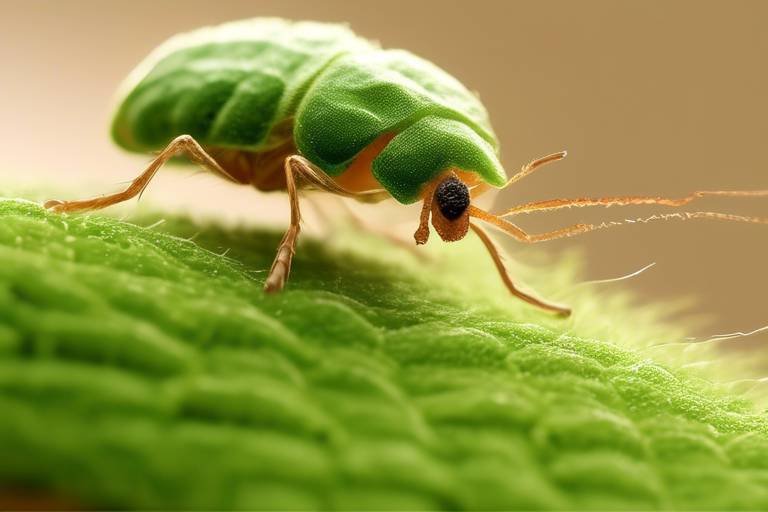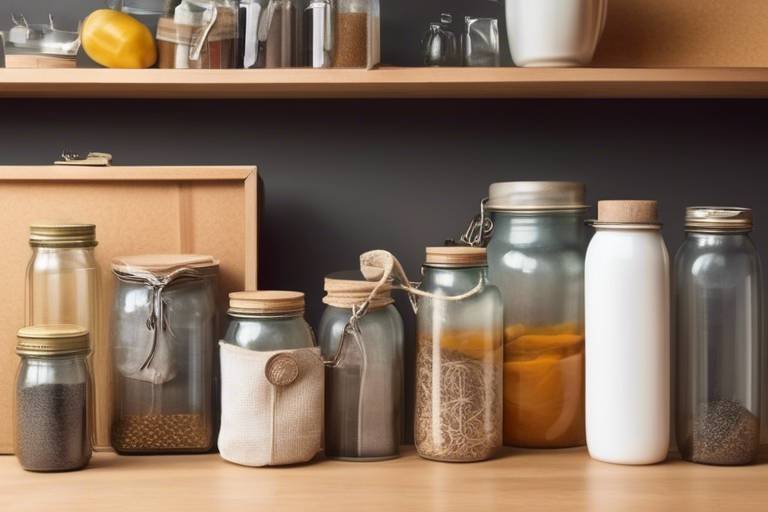Eco-Friendly Pest Control Methods for Your Home
In the quest to maintain a comfortable and safe living environment, pest control often becomes a necessity. However, traditional pest control methods can introduce harmful chemicals into our homes and the environment, leading many to seek out more sustainable alternatives. Eco-friendly pest control methods offer a way to manage pests effectively while prioritizing the health of your family and the planet. By employing natural strategies, you can tackle pest problems without compromising safety.
So, what exactly does eco-friendly pest control entail? It revolves around the idea of using less harmful substances and methods to manage pest populations. One of the foundational principles of this approach is Integrated Pest Management (IPM), which emphasizes a holistic view of pest control. Instead of relying solely on chemical pesticides, IPM combines various strategies, such as biological control, habitat manipulation, and the use of resistant varieties, to create a balanced ecosystem. This not only reduces chemical usage but also promotes biodiversity and the overall health of your garden and home.
Adopting eco-friendly pest control methods comes with a plethora of benefits. Not only do these methods safeguard your household from toxic substances, but they also contribute to a healthier environment. By reducing the reliance on chemicals, you help preserve beneficial insects, maintain soil health, and protect water sources from contamination. Plus, many eco-friendly solutions are often more cost-effective in the long run, making them a win-win for your wallet and the ecosystem.
As we dive deeper into this topic, you’ll discover a variety of natural pest repellents, biological control options, and physical methods that can be employed to keep your home pest-free. Whether you’re dealing with ants in the kitchen or mosquitoes buzzing around your backyard, there are eco-friendly solutions available that are both effective and safe.
At its core, eco-friendly pest control is about understanding the life cycles and behaviors of pests and their natural predators. By recognizing the role each organism plays in the ecosystem, you can make informed decisions about how to manage pest populations. For instance, did you know that certain plants can attract beneficial insects that prey on common pests? This creates a natural balance, reducing the need for chemical interventions.
Moreover, embracing sustainable practices in pest management not only helps in dealing with current pest problems but also prevents future infestations. Maintaining a clean and clutter-free environment, sealing entry points, and regularly inspecting your home can go a long way in keeping pests at bay. Prevention is always better than cure, and when it comes to pest control, this adage holds particularly true.
In the following sections, we will explore specific eco-friendly pest control methods, including natural repellents made from essential oils and herbs, biological pest control through the introduction of natural predators, and physical methods such as traps and barriers. Each of these strategies offers unique benefits and can be tailored to fit your specific pest control needs.
- What are eco-friendly pest control methods? Eco-friendly pest control methods utilize natural products and techniques to manage pests without harming the environment or human health.
- Are essential oils effective for pest control? Yes! Essential oils like peppermint, lavender, and tea tree oil can effectively repel a variety of pests when used correctly.
- How can I prevent pests from entering my home? Regular cleaning, sealing entry points, and maintaining your yard can help prevent pests from becoming a problem.
- What is Integrated Pest Management (IPM)? IPM is a comprehensive approach to pest control that combines various strategies to manage pest populations while minimizing chemical use.

Understanding Eco-Friendly Pest Control
In today's world, where environmental concerns are at the forefront of our minds, eco-friendly pest control has emerged as a critical approach to managing pest problems. But what does it really mean? At its core, eco-friendly pest control focuses on sustainable and non-toxic methods that prioritize the health of both your home and the environment. By adopting these practices, we can reduce our reliance on harmful chemicals that not only affect pests but also pose risks to our families, pets, and beneficial organisms.
One of the foundational principles of eco-friendly pest control is Integrated Pest Management (IPM). This strategy combines different management techniques and practices to control pest populations in a way that minimizes risks to human health and the environment. IPM emphasizes understanding the life cycles and behaviors of pests, allowing homeowners to make informed decisions about when and how to intervene. The goal is to keep pest populations at acceptable levels while reducing the use of chemical treatments.
Adopting eco-friendly pest control methods comes with a host of benefits. Not only do these practices help protect our ecosystems, but they also lead to healthier living spaces. By reducing chemical usage, we can improve indoor air quality and create a safer environment for children and pets. Moreover, many eco-friendly solutions are often more cost-effective in the long run, as they focus on prevention and natural alternatives rather than expensive chemical treatments.
In addition to IPM, a key aspect of eco-friendly pest control is the promotion of biodiversity. Maintaining a diverse garden with a variety of plants can attract beneficial insects that naturally prey on pests. For instance, ladybugs and lacewings are excellent at controlling aphid populations, while birds can help manage a range of other pests. By fostering a balanced ecosystem, we can create a self-regulating environment that minimizes pest problems without the need for chemical interventions.
Ultimately, understanding eco-friendly pest control is about recognizing the interconnectedness of all living things. When we choose to implement sustainable practices, we are not just addressing the immediate pest problem; we are also contributing to the overall health of our planet. By prioritizing eco-friendly methods, we can create a safe, healthy, and sustainable living environment for ourselves and future generations.

Natural Pest Repellents
When it comes to keeping our homes safe from pesky intruders, offer a sustainable and effective alternative to chemical-laden products. These eco-friendly solutions not only protect your living space but also safeguard the environment and the health of your family. Imagine walking through a garden filled with vibrant herbs and essential oils, all while knowing they're working hard to keep unwanted pests at bay. Sounds delightful, right? Let's dive into the world of natural pest repellents and discover how they can transform your home into a pest-free oasis.
One of the most fascinating aspects of natural pest repellents is their ability to harness the power of nature itself. Many common household pests, such as mosquitoes, ants, and spiders, can be deterred by the scent of certain plants and essential oils. For instance, peppermint oil is a well-known repellent that not only smells refreshing but also sends pests packing. Similarly, lavender oil is celebrated for its calming aroma and its ability to keep moths and flies away. The best part? These oils are safe for both humans and pets, making them an ideal choice for households.
In addition to essential oils, there are a variety of herbs that can be grown in your garden or even in pots on your windowsill to naturally repel pests. For example, plants like rosemary, basil, and thyme are not only culinary delights but also serve as effective pest deterrents. Incorporating these herbs into your garden not only beautifies your space but also provides an added layer of protection against unwanted guests. Just picture your kitchen filled with fresh herbs, ready to be used in your favorite dishes while simultaneously working to keep pests at bay!
But how can you effectively use these natural repellents in your home? One popular method is to create homemade sprays using essential oils. Not only is this an easy DIY project, but it also allows you to customize your pest control solutions based on your preferences. For example, mixing a few drops of peppermint oil with water in a spray bottle can create a powerful repellent that can be applied to doorways, windowsills, and other entry points. You can even experiment with different combinations of essential oils to find the perfect blend that works for your specific pest problems.
To give you a better idea of how to use these natural repellents, here’s a simple recipe for a DIY essential oil spray:
| Ingredients | Quantity |
|---|---|
| Peppermint Essential Oil | 10 drops |
| Water | 1 cup |
| White Vinegar | 1/2 cup |
| Spray Bottle | 1 (16 oz) |
Simply mix the ingredients in the spray bottle, shake well, and spray around your home as needed. Not only will your home smell fantastic, but you'll also be creating a barrier against those unwanted pests!
Another effective way to utilize herbs as natural repellents is by creating sachets or potpourri. Dried herbs like sage or mint can be placed in small cloth bags and hung in closets or placed in drawers to deter moths and other insects. This method is not only practical but also adds a lovely natural fragrance to your living spaces.
In conclusion, embracing is a step towards a healthier home and environment. By utilizing essential oils and herbs, you can create a pest-free sanctuary without resorting to harmful chemicals. So, why not give these methods a try? Your home will thank you, and so will the planet!
- Are natural pest repellents safe for pets? Yes, most natural repellents made from essential oils and herbs are safe for pets, but it's always wise to do your research on specific oils.
- How often should I reapply natural pest repellents? It’s recommended to reapply every few days, especially after rain or cleaning.
- Can I mix different essential oils? Absolutely! Experimenting with different combinations can yield effective results.

Essential Oils for Pest Control
When it comes to keeping your home pest-free, essential oils are like nature's little superheroes. They not only smell fantastic but also pack a powerful punch against those pesky intruders. Think of essential oils as your home's first line of defense—safe for your family and the environment, yet effective in warding off unwanted guests. For instance, oils such as peppermint, lavender, and tea tree have been shown to repel a variety of common household pests, including ants, spiders, and mosquitoes. It's like creating a protective shield around your living space, all while enjoying the delightful aromas these oils bring.
Using essential oils for pest control is straightforward and can be a fun DIY project. You can easily incorporate them into your cleaning routine or create your own pest-repelling sprays. Just imagine spritzing your home with a refreshing scent that also keeps bugs at bay! The beauty of essential oils lies in their versatility. For example, a few drops of peppermint oil can be added to your mop water or diluted in a spray bottle with water to create a natural insect repellent. The aroma not only refreshes your home but also sends those annoying pests packing.
However, it’s essential to use these oils safely. Some oils can be potent, so always dilute them properly before application. A common ratio is 10-15 drops of essential oil per ounce of water. This dilution ensures you’re maximizing the repellent properties without overwhelming your space. When applying these oils, consider areas where pests are likely to enter, like doorways, windowsills, and even cracks in the walls. This proactive approach not only deters pests but also keeps your home smelling fresh.
Moreover, it's worth noting that essential oils aren't just effective against pests; they can also be a delightful addition to your home environment. For example, the scent of lavender can promote relaxation, making it a perfect choice for bedrooms. It’s like having a dual-purpose solution—pest control and a calming atmosphere all in one! So, the next time you're looking for ways to keep your home pest-free, think of essential oils as your trusty allies.
In summary, essential oils offer a sustainable and non-toxic approach to pest control. Not only do they help in keeping your home safe from pests, but they also enhance your living space with their delightful fragrances. By incorporating these oils into your pest management routine, you're taking a significant step towards a healthier home and environment.

DIY Essential Oil Sprays
Creating your own essential oil sprays for pest control is not only a fun and creative endeavor but also an effective way to keep your home pest-free without resorting to harsh chemicals. Imagine walking into your home and being greeted by a refreshing scent while knowing that you're also deterring pesky insects—sounds great, right? The beauty of these natural sprays lies in their simplicity and effectiveness. With just a few ingredients, you can whip up a concoction that works wonders against a variety of household pests.
To get started, you’ll need a few basic supplies: a spray bottle (preferably dark glass to protect the oils from light), water, and your choice of essential oils. Some of the most effective oils for pest control include peppermint, lavender, tea tree, and eucalyptus. Each of these oils not only smells delightful but also has unique properties that repel different types of pests. For instance, peppermint is known to deter ants and spiders, while lavender can keep moths and fleas at bay.
Here’s a simple recipe to get you started:
| Ingredients | Measurements |
|---|---|
| Water | 1 cup |
| Essential Oil (choose one or a combination) | 10-20 drops |
| Witch Hazel (optional) | 2 tablespoons |
To make your spray, simply combine the water and essential oils in your spray bottle. If you’re using witch hazel, add that as well—this ingredient acts as an emulsifier, helping the oils mix with the water. Shake the bottle well before each use to ensure the oils are evenly distributed. Now, you’re ready to spray! Target areas where pests are likely to enter, such as doorways, windowsills, and even around plants in your home. Just remember to reapply every few days or after cleaning, as the scent may fade over time.
It’s important to note that while essential oils are generally safe, they can be potent. Always test a small area before applying to surfaces or fabrics, and keep them out of reach of children and pets. With a little bit of experimentation, you can find the perfect blend that suits your home and effectively keeps those unwanted guests away.
Incorporating DIY essential oil sprays into your pest control routine not only helps protect your home but also contributes to a healthier environment. You’re not just spraying for pests; you’re also filling your space with natural aromas that promote well-being. So, why not give it a try? You might just find that creating your own pest control solutions is as satisfying as it is effective!
Q: Are essential oils safe for pets?
A: While many essential oils are safe, some can be toxic to pets. Always research the specific oils you plan to use and consult with your veterinarian if you have concerns.
Q: How often should I apply the DIY essential oil spray?
A: It’s best to reapply every few days or after cleaning to maintain effectiveness.
Q: Can I use essential oils directly on my skin?
A: Many essential oils should be diluted before applying to the skin to prevent irritation. Always perform a patch test first.

Using Herbs as Repellents
When it comes to keeping pests at bay, nature has provided us with a treasure trove of solutions right in our own backyards. Herbs are not only a delightful addition to your kitchen but also serve as powerful natural repellents. Imagine stepping into your garden and being surrounded by fragrant plants that not only enhance your meals but also protect your home from unwanted visitors. Isn’t that a win-win?
Many common herbs possess properties that naturally deter pests. For example, mint is known for its invigorating scent, which is a major turn-off for ants, spiders, and even mice. Similarly, rosemary and basil can help keep mosquitoes and flies away. By incorporating these herbs into your garden or using them in pots around your home, you can create a fragrant barrier that pests find hard to cross.
But how do you effectively use these herbs? One simple method is to crush the leaves of these plants and place them in areas prone to pest activity. You can also create a herbal sachet by drying the leaves and putting them in small cloth bags, which can be hung in closets or placed in drawers. Not only will this keep pests away, but it will also infuse your home with a lovely aroma.
Another fantastic idea is to plant these herbs strategically around your home. For instance, planting lavender near windows and doorways can help ward off mosquitoes and flies. Not only will you enjoy the beauty of these plants, but you’ll also create a natural barrier that enhances the overall ambiance of your space.
To give you a clearer picture, here’s a quick table summarizing some effective herbs and the pests they repel:
| Herb | Pests Repelled |
|---|---|
| Mint | Ants, Spiders, Mice |
| Lavender | Mosquitoes, Flies |
| Rosemary | Mosquitoes, Flies |
| Basil | Mosquitoes, Flies |
Incorporating these herbs into your pest control strategy not only offers a safe and eco-friendly alternative to chemical repellents but also enhances the beauty and functionality of your garden. So, next time you’re in the garden center, consider picking up a few herb plants. You’ll be amazed at how effective they can be in creating a pest-resistant environment while adding a touch of greenery to your home.
In conclusion, using herbs as natural repellents is a simple yet effective way to maintain a pest-free home. By harnessing the power of nature, you can protect your living space without resorting to harsh chemicals. So, get ready to enjoy the dual benefits of beauty and pest control right from your garden!
Q: Can I use dried herbs instead of fresh ones?
A: Yes, dried herbs can be effective as well! Just make sure to crush them to release their oils and scents.
Q: How often should I replace the herbal sachets?
A: It’s a good idea to replace them every few weeks, especially if you notice a decrease in their effectiveness.
Q: Are there any herbs that attract beneficial insects?
A: Absolutely! Herbs like chamomile and fennel attract beneficial insects such as ladybugs and lacewings, which can help control pest populations.

Biological Pest Control
When it comes to keeping your home pest-free, offers a fascinating and sustainable alternative to traditional chemical methods. Instead of relying on harsh pesticides that can harm both the environment and your health, biological pest control leverages the natural ecosystem to manage pest populations. Imagine a tiny army of beneficial insects swooping in to save the day, restoring balance in your garden and home! This method not only helps in controlling pests but also encourages biodiversity, making it a win-win for nature and homeowners alike.
One of the key principles of biological pest control is the use of natural predators. These are organisms that prey on pests, effectively reducing their numbers without the need for toxic chemicals. For example, ladybugs are well-known for their appetite for aphids, while parasitic wasps can help control caterpillar populations. By introducing or encouraging these beneficial species in your garden, you can create a natural defense system against common pests.
In addition to insects, there are also other organisms that play a crucial role in biological pest control. Nematodes, for instance, are microscopic worms that can target soil-dwelling pests like grubs and root weevils. By applying these nematodes to your garden, you can effectively eliminate harmful pests while promoting a healthy soil ecosystem. It's like having a secret weapon in your gardening toolkit!
But how can you effectively incorporate biological pest control into your pest management strategy? Here are a few tips:
- Identify the Pests: Understanding which pests are invading your space is the first step. This knowledge will help you choose the right natural predators.
- Encourage Biodiversity: Plant a variety of flowers and plants that attract beneficial insects. For instance, marigolds can attract ladybugs, while dill and fennel can bring in parasitic wasps.
- Use Organic Methods: Avoid using chemical pesticides that can kill beneficial insects. Instead, focus on organic gardening practices that maintain a balanced ecosystem.
Moreover, biological pest control is not just limited to insects. Microbial pest control, which utilizes bacteria, viruses, and fungi to target specific pests, is another effective method. For example, the bacterium Bacillus thuringiensis (Bt) is a natural pesticide that can be used against caterpillars and other pests without harming beneficial insects. This method highlights the importance of understanding the ecological relationships between different organisms in your garden.
In summary, biological pest control is a smart, eco-friendly approach that can significantly reduce pest populations while promoting a healthier environment. By harnessing the power of nature, you not only protect your home but also contribute to the well-being of the ecosystem. So next time you spot a pesky invader, consider inviting a few natural allies to help you out!
Q: What is biological pest control?
A: Biological pest control involves using natural predators or pathogens to manage pest populations, reducing the need for chemical pesticides.
Q: Are there any risks associated with biological pest control?
A: Generally, biological pest control is considered safe and environmentally friendly; however, introducing non-native species can sometimes disrupt local ecosystems.
Q: How can I attract beneficial insects to my garden?
A: Planting a variety of flowers, herbs, and native plants can attract beneficial insects. Avoid using chemical pesticides to maintain a healthy ecosystem.

Physical and Mechanical Control Methods
When it comes to keeping your home pest-free, are your first line of defense. These strategies are not only effective but also align perfectly with eco-friendly practices. Instead of relying on harmful chemicals, you can create a safe haven for your family while effectively managing unwanted pests. Think of it as building a fortress around your home, where you can keep those pesky intruders at bay without compromising your health or the environment.
One of the most straightforward ways to prevent pests from entering your home is by employing physical barriers. These include things like mesh screens on windows and doors, which act as a shield against flying insects. Imagine a bouncer at a club, only letting in the guests you want and keeping out the troublemakers. Similarly, installing door sweeps can block gaps underneath doors, preventing crawling insects from sneaking in. The goal here is to create a tight seal around your home that pests simply cannot penetrate.
Another effective strategy is the use of traps. There are various types of traps available, each designed for specific pests. For example, sticky traps can be placed in areas where you suspect rodent activity. These traps work like flypaper, capturing pests without the use of toxic substances. You might also consider using humane traps for larger pests like raccoons or squirrels, allowing you to catch and release them far from your home. It’s like playing a game of chess, where you strategically outsmart your opponent without resorting to harmful tactics.
To give you a clearer idea of the different types of traps and barriers available, here’s a quick overview:
| Type of Control | Description | Best For |
|---|---|---|
| Mesh Screens | Fine mesh that covers windows and doors | Flying insects |
| Sticky Traps | Adhesive surfaces that catch pests | Rodents and crawling insects |
| Humane Traps | Live traps for capturing larger pests | Raccoons, squirrels |
| Physical Barriers | Seals and sweeps for doors and windows | Crawling insects |
Maintaining a pest-resistant environment is another crucial aspect of physical control. Regularly cleaning your home, especially in areas like the kitchen and pantry, can significantly reduce the chances of attracting pests. Think of it as a spring cleaning ritual that not only tidies up but also sends a clear message to pests: “This is not the place for you!”
Additionally, proper waste management plays a vital role. Make sure that garbage cans are sealed tightly and that food is stored in airtight containers. Pests are often drawn to easy food sources, and by eliminating these, you create an uninviting atmosphere. It’s like putting up a sign that says, “No food here, move along!”
In summary, physical and mechanical control methods are not just practical; they are a proactive approach to pest management. By implementing barriers, traps, and maintaining cleanliness, you can effectively minimize pest problems while being kind to the environment. These methods empower you to take control of your living space, ensuring that it remains a safe and welcoming environment for you and your loved ones.
- What are the benefits of using physical pest control methods? Physical methods are non-toxic, safe for children and pets, and environmentally friendly.
- How can I maintain a pest-resistant environment? Regular cleaning, proper waste management, and sealing entry points are key strategies.
- Are traps effective for all types of pests? Different traps are designed for specific pests, so it's important to choose the right one for your situation.
- Can I use both chemical and physical methods together? Yes, but it’s best to prioritize eco-friendly options whenever possible.

Traps and Barriers
When it comes to eco-friendly pest control, are your first line of defense. Imagine your home as a fortress, and these methods are the protective walls keeping unwanted invaders at bay. Utilizing physical barriers can effectively prevent pests from entering your living space without resorting to harmful chemicals. Think of it as a natural shield that not only safeguards your home but also contributes to a healthier environment.
There are various types of traps and barriers that can be employed, each designed to target specific pests while ensuring that non-target species, particularly beneficial insects, remain unharmed. For instance, sticky traps are an excellent option for catching flying insects like flies and moths. These traps are coated with a strong adhesive that lures pests in with enticing scents, effectively trapping them without the use of toxins. You can easily place these traps in areas where you notice high insect activity, such as near windows or entry points.
Another effective barrier method is the use of mesh screens. Installing fine mesh screens on windows and doors not only allows fresh air to circulate but also keeps pests like mosquitoes and flies from entering your home. This simple yet effective solution can drastically reduce the number of pests that make their way inside, creating a more comfortable living environment. Additionally, ensuring that any cracks or gaps in your home's exterior are sealed can prevent larger pests, such as rodents, from finding their way into your space.
For those who prefer a more hands-on approach, you can create homemade traps using common household items. For example, a simple trap for fruit flies can be made using a jar filled with apple cider vinegar, covered with plastic wrap, and punctured with small holes. The sweet scent attracts the flies, and once they enter, they find it difficult to escape. This method is not only cost-effective but also a fun DIY project that showcases the effectiveness of natural pest control.
In addition to traps and barriers, maintaining a clean environment is crucial in pest management. Regularly cleaning your home, especially in areas where food is prepared or stored, can help eliminate potential food sources for pests. Ensure that crumbs and spills are promptly cleaned up, and consider storing food in airtight containers to minimize attractants. By combining these physical methods with good housekeeping practices, you create a comprehensive pest management strategy that prioritizes safety and sustainability.
To summarize, utilizing traps and barriers is an essential component of eco-friendly pest control. By incorporating these methods into your pest management routine, you can effectively reduce pest populations in your home while protecting the environment. Remember, a proactive approach is key—by taking steps to prevent pests from entering your home in the first place, you can enjoy a pest-free living space without relying on harmful chemicals.
- What are the most effective traps for common household pests?
Sticky traps and homemade vinegar traps are highly effective for flies, while snap traps work well for rodents. - How can I prevent pests from entering my home?
Sealing cracks, installing mesh screens, and maintaining cleanliness are key strategies to keep pests out. - Are traps and barriers safe for pets and children?
Most traps are safe, but it's essential to place them out of reach of pets and children to avoid any potential accidents. - How often should I check traps?
Regularly checking traps, at least once a week, ensures they remain effective and allows for timely disposal of captured pests.

Maintaining a Pest-Resistant Environment
When it comes to keeping pests at bay, prevention is your best ally. Maintaining a pest-resistant environment is not just about reacting to infestations; it’s about creating a space where pests simply don’t want to invade. Think of your home as a fortress, and you’re the architect designing it to fend off unwanted guests. So, how do you build this fortress? It all starts with cleanliness and proper maintenance.
First and foremost, regularly cleaning your home is crucial. Pests are often attracted to crumbs, spills, and clutter. By keeping surfaces clean, you’re not just tidying up; you’re eliminating their food sources. Vacuuming frequently, especially in the kitchen and dining areas, is a simple yet effective way to keep those pesky insects at bay. Don’t forget to also clean under appliances and furniture, as these hidden spots can become a haven for pests.
Another essential aspect of maintaining a pest-resistant environment is proper food storage. Make sure all food items are sealed in airtight containers. This not only keeps your food fresh but also prevents pests from sniffing out a free meal. Additionally, be mindful of pet food; store it securely and clean up any spills immediately. It’s like throwing a party for pests if you leave food out—so don’t roll out the red carpet!
Moreover, consider the importance of sealing entry points. Pests can squeeze through the tiniest cracks and crevices. Inspect your home for gaps around windows, doors, and even utility lines. Use caulk or weather stripping to seal these openings. This proactive measure not only keeps pests out but also enhances your home’s energy efficiency. It’s a win-win situation!
Another tip is to manage your outdoor space effectively. Keep your garden tidy by trimming back plants and removing debris. Overgrown vegetation can provide shelter for pests. If you have firewood, store it at least 20 feet away from your home and elevate it off the ground to discourage pests from making it their home. Think of your yard as a welcoming area for beneficial insects, not a buffet for the unwanted ones.
Finally, it’s beneficial to maintain a dry environment. Pests like moisture, so fix any leaks in your plumbing, and ensure that your gutters are clear. If you notice damp areas in your home, address them immediately. By keeping things dry, you’re not just preventing pests; you’re also promoting a healthier living environment for you and your family.
In conclusion, maintaining a pest-resistant environment is all about being vigilant and proactive. By implementing these strategies, you can create a home that is less inviting to pests, ensuring that you and your loved ones can enjoy your space without the worry of unwanted critters. Remember, a little effort goes a long way in preventing pest problems before they even start!
- What are the signs of a pest infestation? Look for droppings, nests, and signs of damage to food or property.
- How often should I clean to prevent pests? Regular cleaning, ideally weekly, can significantly reduce the risk of infestations.
- Are there specific plants that repel pests? Yes, plants like marigolds and basil can deter certain pests naturally.
- What should I do if I find pests in my home? Identify the pest, clean the area, and consider eco-friendly pest control methods.
Frequently Asked Questions
- What is eco-friendly pest control?
Eco-friendly pest control refers to methods that manage pest populations without using harmful chemicals. These strategies prioritize the health of your family, pets, and the environment. Techniques include integrated pest management (IPM), natural repellents, and biological control methods that work in harmony with nature.
- How do natural pest repellents work?
Natural pest repellents, often made from essential oils and herbs, deter pests by emitting scents that are unpleasant to them. For example, peppermint oil can repel spiders and ants, while lavender is known to keep moths at bay. These repellents are safe for humans and pets, making them a great alternative to chemical sprays.
- Can I make my own pest control sprays?
Absolutely! You can create effective DIY essential oil sprays using simple ingredients. For instance, mix water with a few drops of essential oils like tea tree or eucalyptus in a spray bottle. Shake well and spray around areas where pests are a problem. It's an easy and eco-friendly way to keep your home pest-free!
- What are some examples of biological pest control?
Biological pest control involves using natural predators to manage pest populations. For example, ladybugs can help control aphid outbreaks, while nematodes can target soil-dwelling pests. By introducing these beneficial insects into your garden, you can reduce pest problems without resorting to chemicals.
- How can I maintain a pest-resistant environment?
To keep your home pest-free, focus on cleanliness and maintenance. Regularly clean up food spills, seal cracks and crevices, and ensure that windows and doors are fitted with screens. By creating an unwelcoming environment for pests, you can significantly reduce the likelihood of infestations.
- Are essential oils safe for pets?
While many essential oils are safe for pets, some can be toxic. It's crucial to research each oil and consult with your veterinarian before using them in your home. Generally, oils like lavender and chamomile are considered safe in small amounts, but always prioritize your pet's safety first!



















